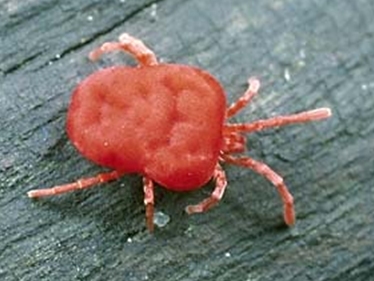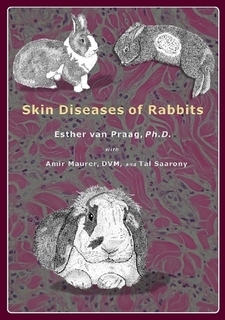Less Common Fur
Mites in rabbits:
Trombicula autumnalis and Dermanyssus
gallinae
Esther van Praag Ph.D.
MediRabbit.com is
funded solely by the generosity of donors.
Every
donation, no matter what the size, is appreciated and will aid in the
continuing research of medical care and health of rabbits.
Thank you
|
Both
parasites infest other species of animals or birds, but have been observed on
rabbits. Trombicula autumnalis, or harvest mite, is found in the fur
of rabbits that have free access to a yard. The female mite lays eggs in the
soil. The hatching larvae, which are barely visible with the naked eye, move
into the grass and wait till a suitable host is found. Only larvae will
attack a rabbit, cat, dog, or human; further developing stadia proceed in the
soil. The parasite will suck body fluids up to 3 times its body size,
after which it will fall down on the soil to complete its life cycle.
Dermanyssus gallinae, also called red mite, may
accidentally be hosted by rabbits living in the presence of birds.
Clinical signs
Larvae
are usually found on the head of rabbits (ears, inner and outer corners of
the eyes, chin), the neck and shoulder regions, under the front legs and
between the toes, and in the perianal region.
Their
presence of these uncommon parasites leads to intense pruritis and the
formation of macules and pustules. Scratching will lead to self-mutilation,
wounds, and the development of secondary bacterial infections.
Diagnosis
Diagnosis
can be difficult and visual examination is not always sufficient to confirm
the presence of ear mites. Detection methods include the tape method, skin
scraping (shallow if fur mites are suspected, deep if burrowing mites are
suspected), or the vacuum aspiration method on a filter paper. Samples from
scraping or aspiration should be spread on a microscope glass, dissolved in
KOH, and examined under a microscope. Great is the chance to see at least one
mite or a larva or eggs. Fur can also be sampled, dissolved in KOH, and
examined under the microscope for the presence of eggs. If no mite is present
in the first sample, other places on the body should be checked. If the
presence of burrowing mites is suspected, but none found after a deep skin
scraping, a biopsy on the area suspected of mite infestation is advisable.
Treatment
Treatment of Trombicula autumnalis may be difficult. While
fipronil, permethrins, and organophosphates are used on other animals to treat
these mites, all have been linked to serious adverse effects in rabbits and
should be avoided. The manufacturer of fipronil (Frontline® - Merial)
strongly advises against using it on rabbits. Serious adverse effects
(depression, anorexia, seizures, death) have been observed in rabbits,
especially young or small rabbits. Dermanyssus
gallinae is best treated with carbamates. The treated rabbit must be closely
monitored, as this type of insecticide can trigger toxic reactions. The use
of a powdered product should be favored, due to poor absorption of the
insecticide through the skin. If any mite problem is
not solved, the presence of infested dogs and cats (both can be asymptomatic
carriers) or survival of the parasite to treatment should be considered. Fur mites (live on the
surface of the skin) can fall off and contaminate the environment. While
treating for mites, careful cleaning of the cage and environment is
recommended. Treatment of the environment is important (boric
acid such as Fleabusters®; Vet-Kem Acclaim Plus® - Sanofi; Staykil® -
Novartis; Indorex® - Virbac; acaricide spray). When treating a carpet, vacuum
first in order to further penetration of the spray or powder. Shampooing and
steam cleaning are not ideal; their residual humidity can increase the mite
problem. During treatment of the environment, rabbits should be kept in
another part of the home to avoid the danger of contact with the products. For detailed information on fur mite infestation in
rabbits, see: “Skin Diseases of Rabbits” by E. van Praag, A. Maurer and T.
Saarony, 408 pages, 2010. Further
Readings
Beck W. Farm animals as disease vectors of parasitic epizoonoses and
zoophilic dermatophytes and their importance in dermatology. Hautarzt. 1999;
50(9):621-8. Cerny V, Rosicky B. Mammals as source of ectoparasites in towns. Folia
Parasitol (Praha). 1979; 26(1):93‑5. Isingla LD, Juyal PD, Gupta PP. Therapeutic trial of ivermectin
against Notoedres cati var. cuniculi infection in rabbits.
Parasite. 1996; 3(1):87-9. Kirwan AP, Middleton B, McGarry JW. Diagnosis and prevalence of Leporacarus
gibbus in the fur of domestic rabbits in the UK. Vet Rec. 1998;
142(1):20-1. Pinter L. Leporacarus gibbus and Spilopsyllus cuniculi
infestation in a pet rabbit. J Small Anim Pract. 1999; 40(5):220-1. Wagner R,
Wendlberger U. Field efficacy of moxidectin in dogs and rabbits naturally
infested with Sarcoptes spp., Demodex spp. and Psoroptes
spp. mites. Vet Parasitol. 2000; 93(2):149-58. |
e-mail: info@medirabbit.com






